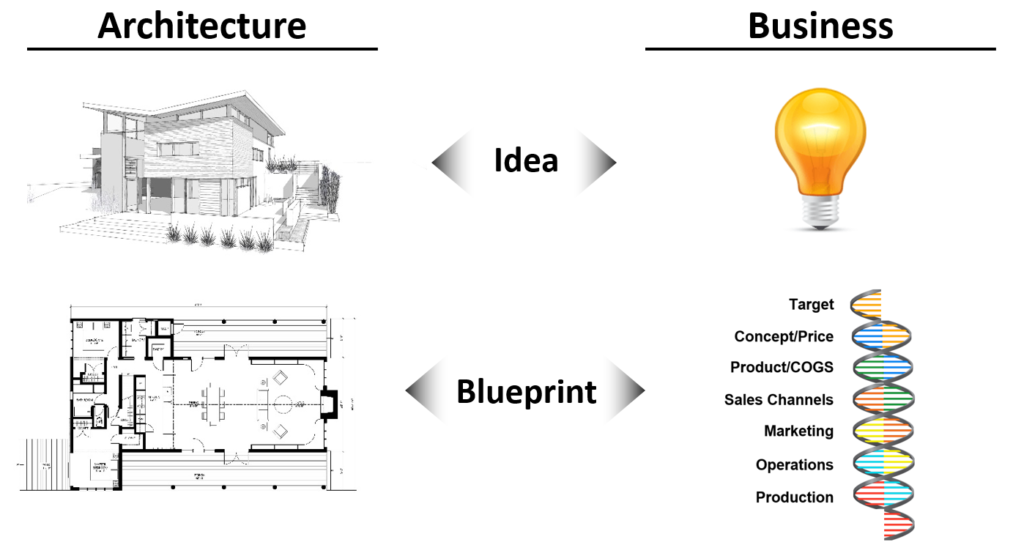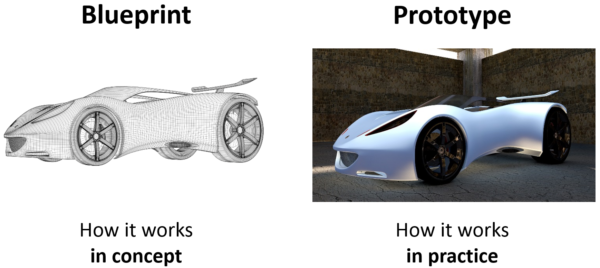
March 1, 2019
The Business Blueprint
4 minute read
You’ve identified a compelling new idea and believe it can be a game-changing new product or business. Yet, the more your team talks about the different ways to take this idea to market, the more you get into circular debates about which approach is best.
We see this often, especially in the early stages of an innovation. And, while it’s healthy to have different points-of-view on how to turn the idea into a successful business, the endless debates can be a drain on team energy and a delay on progress. Worse yet, deciding on a direction based on seniority or “who argues most loudly” can be demotivating to team members. What’s missing is a tool to help teams move from “theoretical” debates to “practical” options that can be objectively evaluated to determine how to best turn the idea into a business.
Architecture has developed just such a tool to handle a similar problem… the blueprint. In architecture, the theoretical idea, or sketch, is used to gauge initial interest, but doesn’t answer the practical question of “how do we put together all of the elements to make this idea work in practice.” That’s the role of the blueprint: move the debate from the theoretical to the practical – can all the elements really work together to deliver the idea. Moreover, the blueprint identifies practical trade-offs that need to be made and enables the team to identify and resolve areas of disagreement. Importantly, a blueprint is NOT the time consuming, detailed final building plan; it’s a middle step that has enough detail and definition to enable meaningful discussions, but does not attempt to create all of the details required for the actual building.
On the “idea-side” of innovation the “concept test” serves as a blueprint-like tool to figure out the choices for how a new product or service gets communicated to a prospective buyer. Yet, on the “business-side” of innovation (i.e. how to turn the idea/concept into a successful business) the primary tool historically has been the business plan. The problem with the business plan is that it’s time consuming and inflexible – more like a detailed final building plan. That’s where the business blueprint comes in. Its job is to enable a team to take a theoretical business and work through the practical choices of how the pieces could fit together – all in a fast and flexible way.
Here’s an example from some work we did with a Fortune 500 company. A new category had emerged that was an “enhancer” to a company’s current product. This new “enhancer” product category was located on a different store shelf from the company’s current product. The company had developed an “enhancer” concept that tested well but was “stuck” in an endless theoretical debate on where it should be shelved. To get out of the theoretical debate, we worked with the team to build a business blueprint for how the business would work if shelved with the base product line and a business blueprint for how the business would work if shelved with the rest of the “enhancer” category.
Overtly “blueprinting” these different options resulted in important learning and insights. For example, the base brand shelf had a different frame of reference that could enable higher pricing (yielding more gross profits that could be used for marketing support) and had more people shopping the shelf (which could lead to a lower cost to acquire a buyer). However, consumers shopping the new category shelf had much higher buying rates, making them more valuable consumers. Net, through “blueprinting” the trade-offs of each shelf became clear. And, in turn, the specific data needed and research to be conducted to make the right choice, likewise, became clear.
Key Points:
- Figuring out how to turn an idea into a successful business is challenging because there are so many different ways to do this.
- This challenge is further amplified by the dozens of interconnected decisions to be made. For example, if Target A, then premium priced, which means different packaging and a different contract manufacturer vs. Target B at a mainstream price with standard packaging and production.
- The business blueprint is a tool that enables a team to explore different approaches for turning an idea into a business in an efficient and productive way.
- A business blueprint defines how all the building blocks of a business fit together, in concept.


